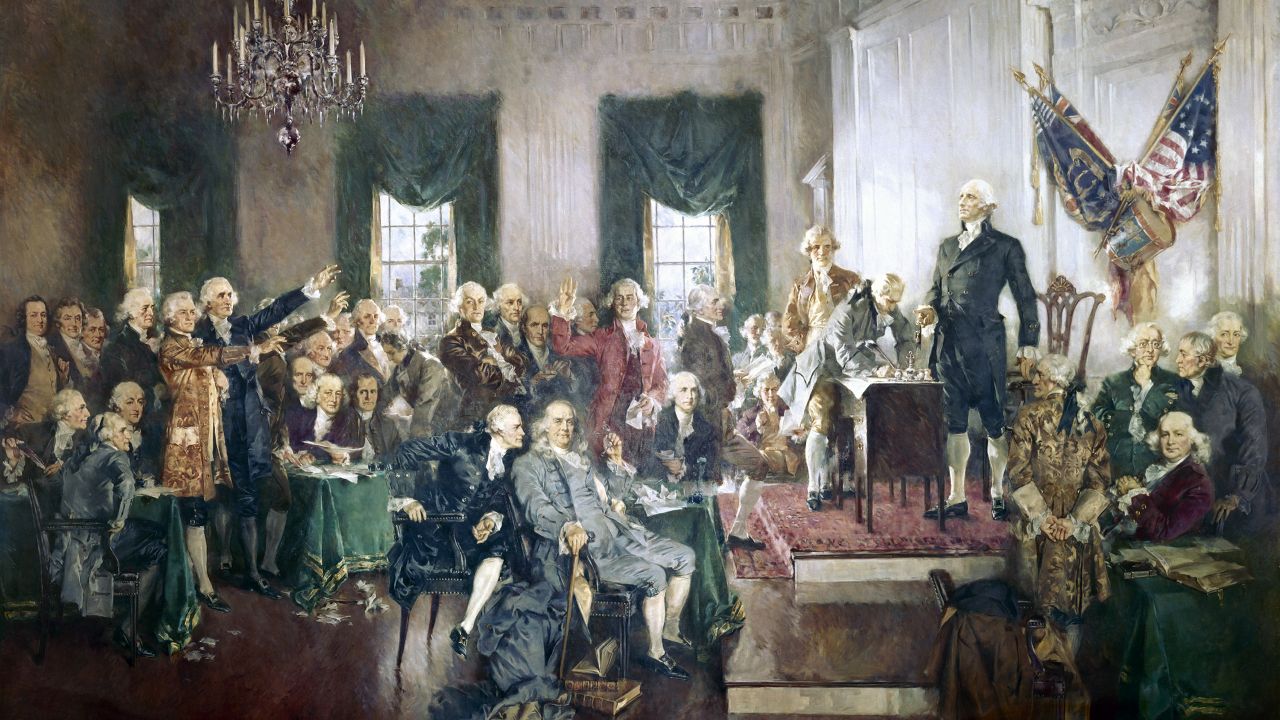
"The Signing of the Constitution of the United States," with George Washington, Benjamin Franklin, and Thomas Jefferson at the Constitutional Convention of 1787; oil painting on canvas by Howard Chandler Christy, 1940. (Photo by GraphicaArtis/Getty Images)
It’s been three weeks since President Donald Trump, with all the usual pomp, swore on not one but two Bibles to “preserve, protect and defend” the Constitution of the United States. If the president has ever read the Constitution, there is little evidence that he understands it, and plenty of evidence that he treats it with indifference. Upholding the US Constitution, however, is the best way to ensure that no one gets fired at the end of the season.

A recent report indicates that President Trump is surprised that the government can’t be run like his businesses. Why can’t it?
Short answer: Presidents don’t have to be licensed like doctors, or pass the bar exam like lawyers. They don’t even have to take the citizenship test required of every immigrant who becomes an American. But they do have to adhere to the separation of powers outlined in the Constitution. As John Adams, one of the framers and the second president of the United States wrote, our country is “a government of laws, and not of men.” The Constitution is, above all, a blueprint designed to protect us from the tyranny of demagogues and kings. James Madison advocated ratifying the Constitution in The Federalist Papers. But he worried that the executive branch, and even more so, the legislative branch, would be power hungry and dominated by self-interest. In Federalist No. 51, he warned, the Constitution is but a flimsy “parchment barrier.”
Constitutional Design
Our Constitution has two organizing principles. One is federalism, dividing power between a central government and the states, which we will save for another time. The other is separation of powers — spelled out in the first three articles of the Constitution. Article 1 sets up the legislative branch, composed of the House and the Senate. Article 2 outlines the executive branch, which includes the president, vice president and the departments. Article 3 explains the judicial branch, made up of the federal courts and the Supreme Court. Each of these branches has certain limited powers. When one branch of government overreaches, it is the job of the other branches of government to rein it in. The framers of the Constitution created this system of checks and balances to limit and diffuse power and protect the citizens from tyranny.
Brief Background
In 1787, over nearly four summer months, 55 delegates to the Constitutional Convention sweated over every detail of the US Constituion in order “to form a more perfect union.” Above all, the framers wanted to guard against a monarchy or a despot taking over the country. They were not the first to think of dividing power; it’s an idea that is traced back to ancient Rome. The Founding Fathers, however, were inspired by the ideas of a French lawyer and political philosopher, Charles-Louis de Secondat Baron de Montesquieu, a contemporary of theirs who coined the term trias politica, or “separation of power.” Montesquieu argued that separating government into the executive, legislative and judicial branches would balance power. But our Founders wanted more insurance against power mongers. This is where those checks and balances come in — to frustrate would-be demagogues.
Checks and Balances
Checks and balances are built-in brakes. As Peter Shane, a professor of constitutional law at Ohio State University, explained, “The idea is to give each branch enough authority to be effective in the discharge of its functions. But they are also given powers that make the other branches partially dependent on one another.” In other words, the separation of powers is not absolute. “It is that balance of independence and interdependence between the branches that is the distinct organizational characteristic of our federal government,” said Shane. The president can negotiate treaties, for example, but the Senate must approve them. The courts can send people to prison, but the president has pardon power. Congress can make laws, but the president has the power to sign or veto them. Even that veto is subject to an override in both houses of Congress. No one branch is supposed to dominate.
Comity
This democratic design doesn’t work unless each branch employs its authority with respect for the equal authority of the other two branches. Law professors call it “comity” — a mutual recognition and civility toward legislative, executive and judicial acts. The norms may change over history, but there is a set of informal understandings that shape the way that everyone interacts. Without this understanding, “things can break down pretty quickly,” Shane said. “Disregarding norms will take a toll over the long term,” agreed Anna Law, a political scientist at Brooklyn College, “particularly if the country becomes immunized and thinks this behavior is normal.”
President Trump seems to test norms of civility on a daily basis. “Presidents have often disagreed with judiciary branch decisions,” said Law, “but what it is unusual and a little scary is that President Trump personalizes his attacks on judges who don’t rule in his favor.” After Trump sent the tweet mocking the “so-called judge” on the Seattle district court who brought the order banning travel from seven countries to a screeching halt, Law said Trump “broadened the scope of conflict, saying that if there is another terrorist attack the entire judiciary is at fault.” This level of disdain, she said, is unprecedented. Shane said he agrees it is serious: “It is an attempt to diminish the dignity of the courts in the eyes of Trump’s supporters.”
Judicial Independence
The judicial branch continues to do its job, despite Trump’s attacks on individual judges. This week a federal appeals court panel upheld Judge James Robart’s decision to halt the travel ban. The court acknowledged that the executive branch has the power to make immigration and national security policy decisions, but it crossed the line, according to the written decision, when it took the position that “the president’s decisions on these policy questions, particularly when motivated by national security concerns are unreviewable, even if those actions potentially contravene constitutional rights and protections.” UC Irvine Law School Dean Erwin Chemerinsky told the Los Angeles Times that the ruling reaffirmed “the most basic aspect of the rule of law: No one, not even the president, is above the law, and it is the role of the courts always to review the constitutionality of government actions.”
Congress
It is also Congress’ job to prevent Trump from trampling democratic norms. Professor Law said she thinks the Republican majority in Congress has been falling down on the job. “The Republicans in Congress have made a Faustian deal: they will tolerate Trump’s behavior if they can get their preferred legislation through,” she said. “The Founders expected Congress to be the most powerful branch since it has the power to fund the president’s plans or not, and it can pass laws that constrain the president.” She said she would like to see a bipartisan group of members of Congress condemn Trump’s actions. Some Republicans have taken initial steps, making it clear they would not let the president reinstate secret prisons overseas or the use of torture. Others have stood up against lifting sanctions on Russia. But for the most part, partisan political interests are prevailing. Professor Shane said Republicans in Congress are “balancing the risks that come from opposing the president with the risks that come from supporting him. The more outlandish his behavior appears to the majority of Americans, the more likely you will see proposals even from the Republican side to regulate or restrain the president.”
Competition
The Constitution emphasizes the notion that robust public policy will be the result of bargaining and deliberation among the branches of government. Extensive deliberation among competing institutions, said Shane, is what helps our government reach a consensus that might best support the public interest. But if Congress is so polarized that it can never agree on controversial issues, he says it gives the president an opportunity to wield his power, no matter how recklessly, in the void. If Congress doesn’t curb the president’s aggressive use of executive power, it may also leave worrisome precedents for the future. “This isn’t just a danger while Trump is in office,” said Shane, “it is a danger going forward.” Everyone must remember the constitutional roles of our democratic institutions, said Law, as well as our own roles, “We the people, with public pressure, have to tell Congress repeatedly to do its job.”




